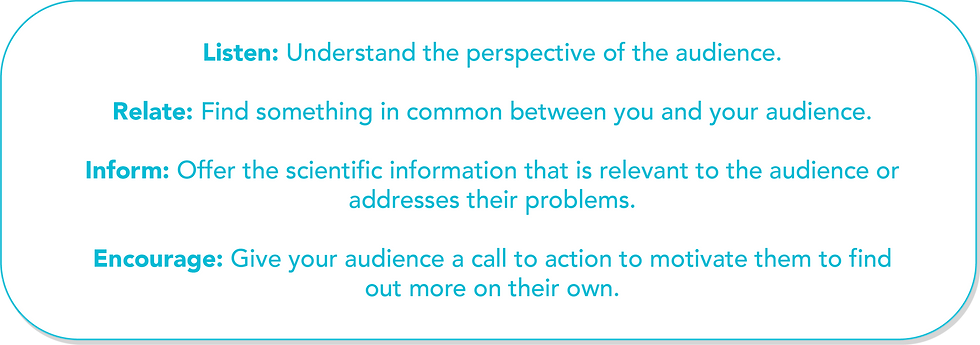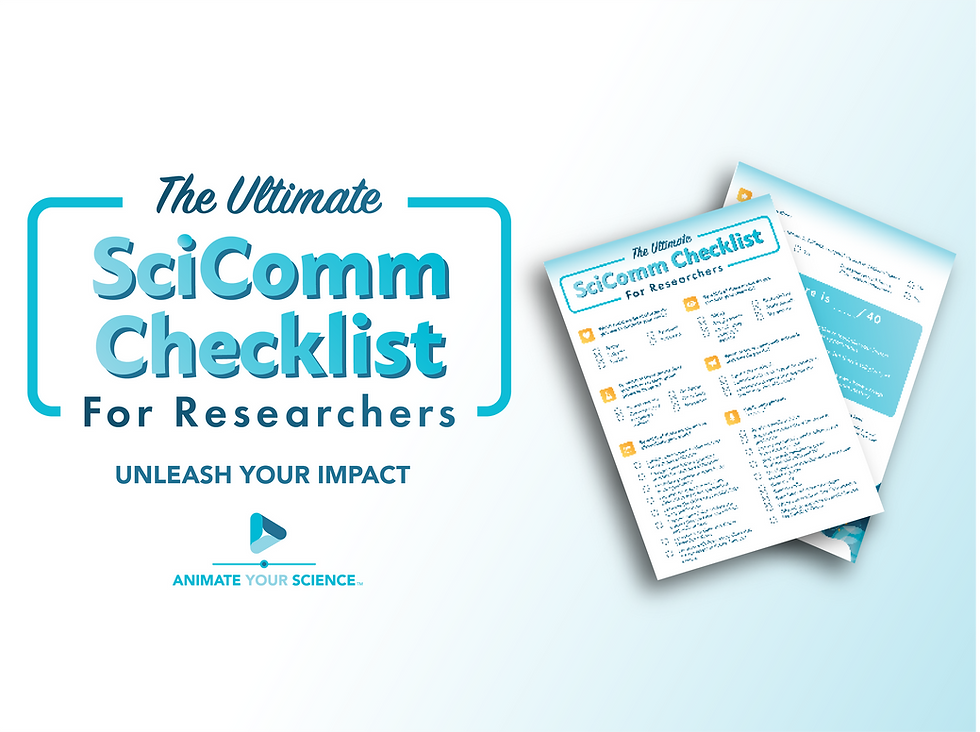Top 5 Science Communication Blogs
- Dr. Miguel Balbin

- Dec 6, 2021
- 7 min read
Updated: Apr 11, 2023
With the internet at our fingertips, there’s no better time to be communicating about science communication! 🙌
You can take your pick from episode-length podcasts, YouTube explainer videos, or our personal favourite: animation. These are all great ways to learn about SciComm while you’re multitasking and on the go.
But what if you’re an avid reader? What’s the perfect way read about SciComm on a laptop or tablet? Or while under a warm blanket on your phone?
You’ve got the choice of SciComm books/eBooks, and there’s some fantastic ones out there.
Or, perhaps you want a casually written SciComm blog (just like this one!)
Indeed, SciComm blogs are great for getting some light reading done on the topic. That’s why we’ve put together our top recommendations for all the fans of this format.

What is a science communication blog?
But before we get to any reading, you may be wondering:
What the heck is a SciComm blog about anyway?
Well I’m glad you asked! But we have to say that there is no single answer, so this is what we think:
Most science communication or SciComm blogs write about techniques for promoting scientific outreach and comprehension. Examples include feature articles on the implementation of graphic design, illustration, social media, stylistic language or other “atypical” channels. These types of blogs are typically written for researchers and science communicators who want to promote their science in new and exciting ways.
Other SciComm blogs may pick a particular topic in science and break it down to its fundamental concepts to make it digestible for the public using SciComm techniques. These types of SciComm blogs are equally loved by researchers and the general public, or from anyone who wants to learn about particle physics WITHOUT committing to a thick textbook.
So unlike the disparity we’ve seen for SciComm and science podcasts, the line between SciComm and more science-centric blogs is somewhat hazier and tends to overlap more between relaying scientific facts vs. teaching science communication skills.
But what’s most important is that you’ll get a lot of value from reading them. Once you’re through with these, you’ll be fully packed on the road to impact!
Top 5 SciComm blogs
PLOS SciComm
PLOS SciComm is the Public Library of Science’s dedicated science communication blog. You’re most likely familiar with PLOS journals like PLOS Biology, PLOS Sustainability and Transformation, and PLOS Climate — all of which are open-access!
Run by a diverse team of interdisciplinary scientists and science communicators, PLOS SciComm’s mission is to promote scientific literacy and citizen science. Indeed, effectively engaging with the public and non-expert audiences is a major focus of their writing. This is to ensure science is accurately and appropriately presented in an engaging way. To do this, they have two main goals, which I quote:

Whether you’re looking for a blog about how vaccines could be explained by illustration, how stand-up comedy and improvisation could add to your next research proposal, or how social media has become VITAL in today’s research environment — you can bet your pipetter you’ll find something that tickles your fancy.
And of course, being part of a journal, they’ve got your fair share of research-centric articles from many different fields of study to pick from too.
I highly recommend checking out these three blog posts for starters:
From the Lab Bench
From the Lab Bench is run by Paige Brown Jarreau who is a science communicator with over 8 years of experience in web writing.
You’ll find that her writing, in the form of personal recounts, web feature stories and magazine-style articles, is both entertaining and valuable to both academic and non-academic readers. Of course, as a scientist first and foremost, she has a wealth of experience writing research manuscripts too. So she understands well how traditional scientific writing is in itself a barrier between scientists and the public.
So, how does she break this barrier down?
Paige’s blog covers a wide range of topics for bridging the academic and public views of scientific research. For one, Paige loves to write about STEM and art (which when combined, becomes the far superior STEAM). Being intertwined between the two fields means that Paige loves to write about how the two could mix in very creative ways.
What’s really cool is that her blog also strongly advocates Women in STEM to encourage girls to take up science at school and to encourage the public to raise female role models across all fields. Indeed, Paige herself makes for a very strong role model for all of her readers.
Lastly, as a keen blogger, you’ll find a plethora of blogs about, well, how to write blogs. Who would’ve thought! If you’re looking to write a SciComm blog yourself, you may find some of Paige’s tips to be quite handy!
Keen to check out her blog? Let’s start you off with these three articles:
ScienceTalk
ScienceTalk’s blog is run by Jennifer Ma and the non-profit volunteer-run organisation of the same name. Their mission statement is to empower and inspire the SciComm community and ultimately influence world decisions.
True to their name, ScienceTalk is all about harnessing the power of conversation as a tool for science communication. In their blog series titled “Compassionate Science Communication”, they go into detail about how we need to write for the needs of the audience, and not for ourselves. After all, scientific publishing is all about increasing your readership (and hopefully citations), and there’s no better way to do that than by ensuring your writing is as accessible as possible. This is dependent on language, tone, and use of appropriate vocabulary.
They propose a model called “Listen, Relate, Inform, Encourage” which is based on the concepts of sympathy and empathy. To explain it in a nutshell, we’ve paraphrased their main messages:

Looking to learn more about how the art of conversation could be your one-way ticket to SciComm glory? Check out these blogs for starters:
Soph Talks Science
Sophie Milbourne is a stem cell biologist-turned-science communicator who runs a blog on her website Soph Talks Science. On top of that, she hosts an amazing SciComm podcast called “The SciComm Toolkit” which we wrote about in a previous post.
Sophie writes about her journey which started in a stem cell culture facility and has written many articles about how her field is making an impact in the world today. But putting the nitty-gritty science aside, she now primarily writes about life as a science communicator and what it means to identify as one. To this end, Sophie has identified that many science communicators were originally scientists with a vision for changing how science is disseminated. She is a huge advocate for the use of social media for promoting research findings and encourages everyone to make their own blog to highlight their day in the life of a scientist. Yes, that includes blogging about the failed experiments too!
Her blogs are a mixture of video blogs (vlogs), written articles as well as step-by-step guides on the latest tips for SciComm mastery. You’ll be sure to find a format that’s right for you.
If you’re looking to find out more about what it means to be a science communicator, make sure to check out:
Who is your science communication for and how to find the right audience
And if you’re super keen, check out her podcast too!
Science Needs Story
Science Needs Story is run by Randy Olson, the renowned author of the book “Connection: Hollywood Storytelling Meets Critical Thinking”. This is our number one favourite SciComm book, though you’ll learn a lot of the same lessons through the blog.
Randy is marine biologist-turned-filmmaker and science communicator. As a scientist who lives at the intersection of two very different worlds, he certainly brings some novel communication ideas to the lab bench. His greatest idea, which he has written countless blog posts about, is to boil down the art of storytelling into three simple words:
And. But. Therefore.
In a story structure, the facts and background are connected with and, the conflict or gap is brought in by but, then the resolution is finalised with therefore. Put together, it’s the ABT template. You can utilise the ABT template to summarise any story - including research studies - into a single paragraph or sentence.
Here’s an example:

Besides preaching about the brilliance of the ABT template, Randy also writes about making use of narrative elements (which of course, he wrote another book about) for writing research articles. Outside of writing techniques, he blogs a fair amount on climate science, filmmaking, comedy, recent world news and a few political pokes here and there. You’ll have a lot to think about after tackling nearly 200 handcrafted posts!
If you’d like to get started with his blog, have a taste-tester with these posts:
Take-away messages from each blog
Have you found a blog that satisfies your taste in SciComm? Here’s a rundown of what we think each blog’s biggest messages are.
PLOS SciComm: Scientific literacy and public understanding are two halves of the same coin.
From the Lab Bench: Cracking barriers in academia means choosing the right words and representing all people equally.
ScienceTalk: Honing your conversation skills is your one-way ticket to making a lasting impact with your audience.
Soph Talks Science: Anyone with a passion for science and a vision for better communication in academia can become a great science communicator.
Science Needs Story: Storytelling and narrative are key for effective science communication.
Have an appetite for more SciComm?
We hope that these blogs have given you the insight you needed into the world of science communication. But just in case you’re hungry for more, let me remind you that you’re currently sitting on a SciComm goldmine!
Over the years we’ve written about our take on what science communication means to us at Animate Your Science. You’ll find many guides on boosting your SciComm game using visual media and graphic design tools for making engaging graphical abstracts, scientific posters, scientific illustrations and even your very own science animations!
You can also take our 5-minute quiz to gauge your SciComm prowess. Who knows, you might already be a master! 🤔
See you in the next post.
Authors:
Dr Juan Miguel Balbin
Dr Tullio Rossi













